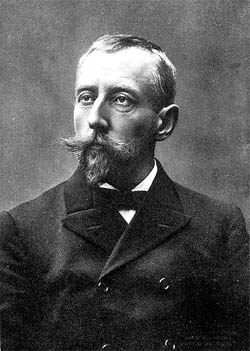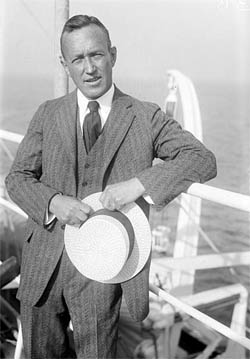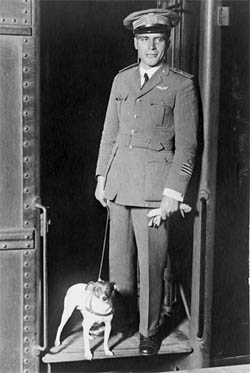pop up description layer
HOME
Cryptozoology UFO Mysteries Aviation Space & Time Dinosaurs Geology Archaeology Exploration 7 Wonders Surprising Science Troubled History Library Laboratory Attic Theater Store Index/Site Map Cyclorama
Search the Site: |
|
The Flight of the Norge (Part I)
It was a feat that was astounding at the time, but now lost in the dusty pages of history. In May of 1926 a group of sixteen fearless adventurers boarded a small dirigible to fly over the North Pole. The audacious journey would be the first ever flight from the European continent to the American continent over the Arctic ice cap. The tiny lighter-than-air craft they piloted they named the Norge. Man had long dreamed of going to the North Pole by air, but often these adventures failed or ended in tragedy. In 1897 the Swedish engineer, Salomon Andrée, along with 2 companions, attempted to cross the pole using a hydrogen-filled free balloon. The balloon traveled for 65 hours across 295 miles of frozen landscape until they were forced down by heavy winds and icy rain. The group, equipped with supplies and sledges for just such an emergency, headed south, but perished before safety could be reached. Their fate was not known until 1930 when their frozen diaries were discovered at their final camp. In 1907 in a dirigible named the America,Walter Wellman also attempted to fly to the pole across the ice. His party left Smeerenberg, Norway, in the tiny 165-foot-long ship but only made it 35 miles. Two years later they made a second attempt , but this time the America was forced to turn back after 60 miles. Amundsen, Ellsworth and Nobile In 1925, Roald Amundsen, the Norwegian discoverer of the South Pole, collaborated with American explorer Lincoln Ellsworth and four other men to try to fly to the North Pole using two Dornier seaplanes. They made it as far as 87° 44' north, within 120 miles of the pole. This was the northernmost latitude reached by an aircraft up to that time. At that point one of the planes became hopelessly damaged in a landing on the ice. The group was forced to camp on the pack for more than three weeks while the world thought that the expedition had been lost. Stubbornly surviving against the odds, the group finally cleared a runway by shoveling 600 tons of ice out of the way, then packed everyone into a single plane and flew home.
Despite this close shave, Amundsen and Ellsworth were eager to try flying to the pole again, but this time the Norwegian insisted on using a lighter-than-air craft. One of the pilots from the previous expedition, Riiser-Larsen, who had recently become qualified in such airships, recommended talking to Colonel Umberto Nobile, who had recently designed and built a dirigible for the Italian army designated the N-1. Nobile, who was a 40-year-old military aeronautical engineer, had been considering such a polar trip himself. He enthusiastically came to Norway to discuss the expedition with Amundsen and Ellsworth. Ellsworth, who was wealthy, was willing to donate $85,000 to underwrite the trip with the Aero Club of Norway covering the rest of the costs. Nobile told them that the Italian Premier, Benito Mussolini, would donate the use of N-1 to the cause if the Italian flag was flown during the flight. Amundsen, who could be hypersensitive about getting the credit for an expedition, refused this offer as he considered the venture strictly a Norwegian/American affair. Nobile countered that the Italian government would be happy to sell the N-1 to the pair for $75,000. He even offered to pilot it himself if an experienced Italian crew was used. Amundsen agreed, if he could have his own men handle the rudder, elevators and navigation. Nobile assented, but insisted that he should have the authority to turn the ship around if the flight became too dangerous. Amundsen wouldn't hear of it, however, and Nobile finally acquiesced, agreeing to pilot the craft after he was given a promise that he would be consulted on all major decisions. The Norge The N-1, now renamed the Norge, was outfitted for the trip. The airship was in several ways unlike most other dirigibles of its era. Most of these spindle-shaped airships had a rigid frame that ran through the entire ship. Within this frame, large cells filled with a lighter-than-air gas (usually hydrogen) provided the lift for the ship. Because the hull of the vessel wasn't just a simple balloon, it was possible for members of the crew to move around inside to maintain it.
The Norge, however, was a semi-rigid dirigible 347 feet (106m) in length. Like the modern advertising blimps of today, the hull was a flexible gas bag with a spindle shape. Unlike a blimp, however, it had a rigid frame on the bottom of the gas bag that ran from the nose of the ship to the tail. This "keel" allowed the crew to move back and forth along the whole length of the craft. Like both the blimps of today and the rigid dirigibles of its own era, the Norge also had a control cabin that hung beneath the hull where the ship's steering was located. Also, like other airships of the day, the Norge had external gondolas or pods that hung down from the hull and contained the engines. There were three of these, each with a propeller that faced the rear of the ship designed to push the craft forward at speeds up to 70 mph (115km/hr). By May the Norge was parked at its jumping off point at King's Bay, near Spitzbergen, Norway. Within sight of the dirigible's hanger, a group of Americans led by Admiral Richard Byrd was preparing to fly to the pole by plane. Amundsen, Ellsworth and Nobile were anxious to get their expedition in the air first, but it was not to be. On May 8th the Josephine Ford, a Fokker tri-motor plane, lifted off the ground and 15 hours and 57 minutes later it returned with Byrd claiming a successful flight to the pole. Byrd's success dampened the crew of the Norge's enthuisam only slightly as they had their own record to break: The first crossing of the North Pole from Europe to America. The morning of departure the ship had been packed with supplies for the flight and emergency equipment should they need to abandon the airship. Ellsworth wrote: The keel of the “Norge” looked like a flying storehouse when all was ready for the start at 8.55 o’clock on the morning of May 11, 1926. The equipment included tents, sleeping-bags, skiis, snow-shoes for those who couldn’t ski, rifles, shot-guns, ammunition, a handsledge—the finest piece of workmanship I ever saw—made by Oskar Wisting on the “Maud,” and a canvas boat. Early that morning the Norge lifted into the air, turned north, and started its own voyage into history. Byrd, in the Josephine Ford, escorted the airship for the first hour, then with a wave, turned back, leaving the airship crew of 16 on their own above the empty, frozen wastes. North to the Pole Now that the flight was underway, a quiet serenity enveloped the control cabin. In the months preceding the flight, Amundsen and Nobile had argued and bickered with Ellsworth serving as a mediator. Once underway, however, the men's differences faded as they concentrated on making the expedition successful. The first few hours of the flight went without incident. Below them the crew could see the shadow of the little airship moving across the ice. Polar bears were startled by the monster in the sky and dove into the sea. Several white whales, wary of the beast overhead, swam under the ice pack so they could hide.
At about 10:30 that morning, fog began to close in around the ship. This condensed onto the Norge, coating it with ice. Nobile ordered the aircraft to climb to 2130 feet to see if they could break out of the mist. This failed and Nobile ordered the ship up another thousand feet. This finally put them in clear skies. At this altitude, however, the thermometer plummeted to a chilly 12 degrees below zero. As the Norge pased latitude 87 degrees, 43 minutes North, Amundsen and Ellsworth exchanged glances. It was here last year that the two had been stranded on the pack for a horrific 25 days before escaping home. At 6 PM that evening, the port motor suddenly stalled. The Norge had been conserving fuel and running on only two of its three engines with the starboard motor kept in reserve. This engine was fired up, came to life with a roar and the ship lost almost no time in the transition. Attilio Caratti, the mechanic assigned to the port gondola, spent the next few hours trying to correct the problem. After much cursing, he found that ice had clogged the fuel line of his engine. By 7:55 PM Caratti had cleared the pipe and gotten the engine started again so the starboard motor could be shut down. The ship plunged onward for another three hours. As they drew within a hundred miles of the pole, however, a wall of solid fog rose up to greet them, a worrying development. Might they overfly the pole, but never even see it? Nobile ordered the ship back up to 3,000 feet to get above the sea of mist below them. A clear view was important at this stage of the trip. This far north the magnetic compasses became unreliable and the ship had to be steered by using a device that measured the position of the sun (which was up all night in the artic that time of year) against the horizon. Because the surface below them was totally clouded over, using this instrument was vital. At one point the crewman in charge of it got distracted by other duties and failed to keep the mechanism aligned properly with the axis of the earth. This caused the pilot to accidently fly the dirigible around in a circle, costing them valuable time and fuel. Finally, when the clock struck midnight, the tension was broken by a little celebration. It was Ellsworth's 46th birthday. "It isn't often," remarked Amundsen, "that you can fly over the North Pole on your birthday." "Ready the Flags!" As the minutes wore on the sky began to clear. At 1:15 A.M. Riiser-Larsen, in charge of the sextant, stood at the starboard window. Intently he squinted into the instrument. When the reflection of the sun touched the sextant's artificial horizon, the aircraft would be over the North Pole. "Ready the flags!" he warned as the ship approached the very top of the world.
Amundsen held a Norwegian flag out the open window. It was mounted on a weighted spear designed to stick into the ice when it hit the ground. Ellsworth held an American flag with the same arrangement. Nobile ordered one of the crewmen to get the Italian flag. At exactly 1:30 in the morning on May 12, 1926, Riiser-Larsen shouted, "Now we are there!" The pilot put the airship into a tight circle and the flags were thrown from the window, fell and implanted themselves in the ice below. The crew shook hands and congratulated each other. They had made it to the pole. After a small celebration that included the only hot meal they would get during the voyage - meatballs immersed in hot grease from a large thermos cask - the group turned their attention to the next task. The most difficult section of the voyage, however, lay ahead. They would need to navigate a portion of totally unexplored territory between them and Point Barrow, Alaska. The airship turned toward North America and started its way south. Amundsen, knowing that the time in Alaska was eleven hours later than where they had started in King's Bay, joked with Ellsworth that he was 45 years old again. "Your birthday lasted only an hour and a half," laughed Amundsen. "Yes," replied Ellsworth, "but I'll have another in a few hours." Below them the glittering ice was beautiful, but desolate. They soon passed the "Ice Pole" - the center of the polar ice pack - which was considered the most inaccessible spot on earth, a bad place to be forced down if anything went wrong. The little dirigible continued to drone south passing through another bank of fog. At 5:19 that evening a cry of excitement rang through the ship. To the west of them loomed a mountain ridge. The adventurers turned the Norge toward it to get a better look. In 1906, Robert Peary, who would be the first man to reach the North Pole by land in 1909, stood on a hill at Cape Colgate, a point in the extreme northwestern part of North America. From there he saw the tops of mountains out to sea at a distance that he estimated to be 120 miles. He named this island, "Crocker Land" after one of his financial backers. Seven years later an expedition from the American Museum of Natural History spent a small fortune trying to find "Crocker Land" but left believing that what Perry had seen was just a mirage, a notoriously common feature in the Artic. If what they saw ahead of them was truly there, Peary had been right after all, and the crew of the Norge was about to make an astounding discovery. As they approached the mountains, however, they began to fade. "It's just a Cape Fly-away!" laughed Amundsen, using the term for an Arctic mirage. The crew, disappointed, turned the ship back to its original course. They had successfully reached the pole, but getting back to civilization safely would be the more challenging part of the trip. Read about that in part II.
Copyright Lee Krystek 2013. All Rights Reserved. |
|
Related Links |
|
|









